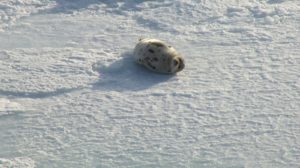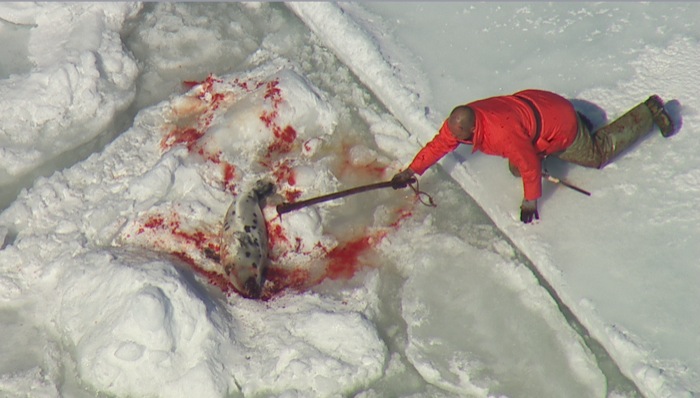Amelia Ruthven-Nelson
Recruitment Manager
When I went to the press conference held by Humane Society International (HSI) to discuss the idea of buying out the seal industry, I was expecting to be bombarded with horrible pictures of bloody seals. This was not the case. The conference was largely informative, and HSI stayed away from personal guilt trips or blaming. Instead, it was a call to action: a conference to bring attention to the unnecessary hunt in hopes of one day stopping it altogether.

The majority of the conference focused on footage that was filmed at this year’s hunt. Although the footage was difficult to watch, it was extremely tactful. As it played, Senior Research Fellow Dr. Andy Butterworth narrated the events and pointed out the key problems of the hunt in terms of animal cruelty. “This is not intended to shock you, it’s intended to inform you” the doctor said repeatedly as he rewound certain clips in order to point out injustices suffered by the seals. The worst part of the hunt was not the actual killing of the seals but failure to ensure that the seals were dead before they were dragged across ice, tossed on a ship, and skinned.
There are laws to ‘protect’ the seals, and sealers must follow multiple procedures while on the hunt, however because of the vast number of sealers and difficult weather conditions, it is impossible to monitor most of what takes place during the slaughter. The laws are not enforced and they are not enough. It’s called the ‘commercial seal slaughter’ but, from what I saw, slaughter isn’t a harsh enough word. Despite the video only showing us a few cases of what went on – it was as diplomatic as ever, with as little blood and guts as possible – I felt like I was watching an animal version of Criminal Minds.

But the biggest problem is what will happen in six months from now. As Rebecca Aldworth, Executive director of HSI, pointed out, “ in just six months time, mother seals will migrate back to Canada’s ice floes and begin the process of giving birth to their cubs, beginning in the spring another seal hunt will happen”.
First of all, the majority of seals being slaughtered are barely three months old, which hardly seems humane. When I envision a hunter in a forest, I imagine some form of fairness; they are hunting mature animals, not Bambi, the animals have a chance to outrun the hunter, they know the forest, and they have a chance to survive. At the slaughter the seals have no chance. The majority of the seals are so young they have not had a chance to become comfortable in the ocean; they are trapped jumping from one ice block to another. There are so many sealers that even if the seals do escape, they are probably escaping to another sealer.
For the sealers, it’s all about getting the job done quickly and they often take on a ‘gold rush’ mentality. They try to get the most amount of seals in the shortest amount of time possible, which means they rush through or skip procedures altogether. From what I saw, the slaughter was more like a bloodbath.
As I watched the sealers step on the bodies of dying seals as they removed hooks from their faces, I found it hard to accept that these sealers could be everyday people. I just couldn’t imagine these people going home to their families and children. The way they callously treated the baby seals was chilling. I do not think they were purposely being cruel to the seals, but the idea of ‘time is money so forget about the seals as living creatures and get as many as possible’ has been engraved in their minds so firmly that they can’t stop themselves.
I understand that it was all about the money, but I still don’t understand how they could hook the mouths of seals and, with their mouths still moving, drag them by their faces.
I still have to remind myself that as HSI pointed out many of the sealers are in favour of the government buying out the sealing licences and finding new ways for them to earn money. Sealing only makes up around 5 per cent of the hunters’ yearly income and majority of Newfoundlanders (where the slaughter takes place) are for the buyout. The slaughter is not a lucrative business, so the main reason the government seems to be putting off the buyout is because it wouldn’t affect their popularity. Instead they focus on taxes and how Canadians can save money as a whole.
I don’t think there is a moral dilemma here, the solution is very clear; stop the commercial slaughter of seals. The only reason the government isn’t really doing anything about this is because they don’t think Canadians care.
When I left the conference I felt deflated. I don’t think I’ve ever been so disappointed in my own country than I was today. The USA and most of Europe will not buy our seal products because of the inherent cruelty in the slaughter. As a country we tend to think of ourselves as progressive and kind, but all over the world people are against a slaughter where Canada produces the most amounts of animal deaths, waste, and cruelty against animals. Like many, I find it difficult to look at images of animal cruelty, and I often go out of my way avoid thinking about how animals are treated. This information needs to get out to Canadians everywhere. As terrible as it was, I don’t regret watching the video. It showed me that all it really takes to stop this is being informed about what is going on and then doing something about it.
Canada Fails to Care


